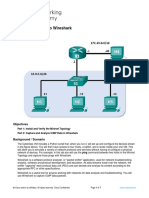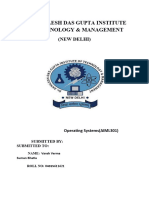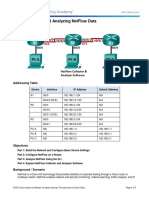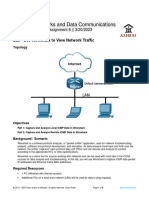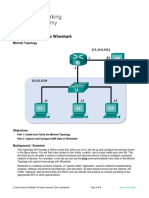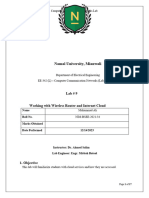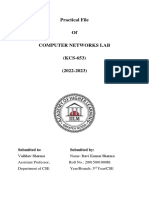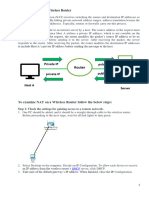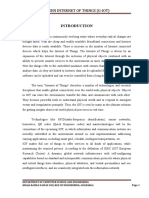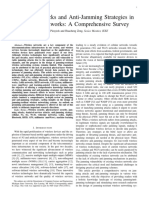DC Rec Remaining
DC Rec Remaining
Uploaded by
bilnot9Copyright:
Available Formats
DC Rec Remaining
DC Rec Remaining
Uploaded by
bilnot9Original Title
Copyright
Available Formats
Share this document
Did you find this document useful?
Is this content inappropriate?
Copyright:
Available Formats
DC Rec Remaining
DC Rec Remaining
Uploaded by
bilnot9Copyright:
Available Formats
IT18511 -Data Communication and Networking Laboratory
SIMULATION OF DYNAMIC HOST CONFIGURATION PROTOCOL
Exercise No: Date:
AIM: To implement the simulation of the dynamic host configuration protocol using cisco
Packet Tracer.
PROCEDURE
1. Run Cisco Packet Tracer Student.
2. Build the network topology by adding devices (Router, Switch, PC etc.) and connect-
ing them with ethernet cables.
Register No: 2127210801074 Page No:
IT18511 -Data Communication and Networking Laboratory
3. Select the Router and click on CLI – Command Line Interface
4. On the router, configure interface fastEthernet 0/0 to act as the default gateway for
our LAN and specify the IP address.
Register No: 2127210801074 Page No:
IT18511 -Data Communication and Networking Laboratory
5. Configure DHCP server on the Router. In the server define a DHCP pool of IP ad-
dresses to be assigned to hosts, a Default gateway for the LAN and a DNS Server.
6. Click PC->Desktop->IP configuration and enable DHCP for every PC in the network.
Register No: 2127210801074 Page No:
IT18511 -Data Communication and Networking Laboratory
7. Every PC should be able to obtain an IP address, default gateway and DNS server, as
defined in step 4. The configuration can be tested by Ping command.
RESULT:
Simulation of the dynamic host configuration protocol was implemented successfully using
cisco packet tracer.
Register No: 2127210801074 Page No:
IT18511 -Data Communication and Networking Laboratory
ESTABLISH LOCAL AREA NETWORK(LAN)
Exercise No: Date:
Aim: To simulate a Cisco Packet Tracer for Establishing a Local Area Network (LAN) with
4 hosts and a switch/Hub.
PROCEDURE :
STEP 1 : Open Cisco packet Tracer student software in your PC after installing.
STEP 2 :Drag and drop four PCs from the bottom list of devices which is highlighted in the
image.
Register No: 2127210801074 Page No:
IT18511 -Data Communication and Networking Laboratory
STEP 3 : Now Drag and Drop a switch from the same list of devices.
STEP 4 : Now connect all the PC s with the common switch in the middle using cable found
in the bottom area.
Register No: 2127210801074 Page No:
IT18511 -Data Communication and Networking Laboratory
STEP 5 : Now as this is static,we have to assign IP address for each and every PC s by
clicking the PC and click desktop and click IP Configuration the a window like this will
appear where you can give the IP address.And after giving IP address the Subnet Mask will
be created automatically by just clicking that column.And we can close this window now.We
have to repeat this process for all the PC s in our network.
Register No: 2127210801074 Page No:
IT18511 -Data Communication and Networking Laboratory
STEP 6 : Now Try sending a packet from one PC to any other PC in the network by clicking
this Message icon in the right side of the window and click on the Source node and
Destination node.If the message tranfers Successfully , you will get the last status as
Successful.
Result:
Register No: 2127210801074 Page No:
IT18511 -Data Communication and Networking Laboratory
Thus ,the simulation of a Cisco Packet Tracer for Establishing a Local Area Network
(LAN) with 4 hosts and a switch/Hub has been implemented successfully.
Simulation of Cisco Packet Tracer
Exercise No: Date:
AIM: To implement Simulation of Cisco Packet Tracer to Connect two LANs using multi-
router topology with static routes.
Procedure:
Steps to Connect two LANs using multi-router topology with static routes
1. Open Cisco Packet tracer software
2. Drag 4 Pc’s using end device icons
3. Drag 2 cisco’s switches using switch icon list
4. Drag 2 cisco’s routers using router icon list
5. Make the connection between the routers and switches using copper straight trough
cables
6. In the same way connect the switches and the routers using the copper straight trough
cables.
Register No: 2127210801074 Page No:
IT18511 -Data Communication and Networking Laboratory
7.To configure one router to another,click one router ,click on WIC-2T,it will show a
physical view device,in that turn the power off and drag The dual-serial port WAN in-
terface cards (WICs) in to the physical device.
8.do the same step second router and configure both the router using Serial DTE ca-
ble.
Register No: 2127210801074 Page No:
IT18511 -Data Communication and Networking Laboratory
9.Click on the first router ,go to config select FASTETHERNET 0/0 and the port status must
be turned on .Select serial 0/0 /0 and the port status must be turned ON.
10.do the same steps for second router.
11.In the the first router ,go to config select FASTETHERNET 0/0 and type the IP address as
192.168.1.1 and subnet mask will be auto generated.repeat this process again in second router
with IP address 192.168.2.1
12.Click on the PC0 and select desktop and go to IP configuration.Give the IP address as
192.168.1.2
And default Gateway as 192.168.1.1
Register No: 2127210801074 Page No:
IT18511 -Data Communication and Networking Laboratory
13. repeat the step 12 for other 3 pc’s. For pc1 the
IP address is 192.168.1.3
Default Gateway is 192.168.1.1
For Pc2 the
IP address is 192.168.2.2
Default Gateway is 192.168.2.1
For PC3 the
IP address is 192.168.2.3
Default Gateway is 192.168.2.1
14.click on to first router again ,click on config and select SERIAL0/0/0 and write the IP
address as 192.168.3.1
15. Repeat the step 14 again for the second router and write the IP address as 192.168.3.2
Register No: 2127210801074 Page No:
IT18511 -Data Communication and Networking Laboratory
16.Click the first router ,select config and select STATIC,The
Network:192.168.2.0
Mask:255.255.255.0
Next Hop:192.168.3.2
Now select RIP ,
Network:192.168.3.0
192.168.2.0
Repeat this step for second router but the
Network:192.168.1.0
Mask:255.255.255.0
Nexthop:192.168.3.1
Now select RIP Routing the
Network:192.168.3.0
192.168.1.0
Register No: 2127210801074 Page No:
IT18511 -Data Communication and Networking Laboratory
17.Now to execute it,select the data packet ,drop one in source and another in the
destination.click on the simulation and click on auto capture /lay to see the visual movement
of the data packets.once the process in complete it will show the process is successful.
Register No: 2127210801074 Page No:
IT18511 -Data Communication and Networking Laboratory
18. to check the connection is correct select a end device select desktop and select command
prompt and write the follwing commands
Ipconfig
Register No: 2127210801074 Page No:
IT18511 -Data Communication and Networking Laboratory
Ping 192.168.2.2
Result:
Thus the implementation of Simulation of Cisco Packet Tracer to Connect two LANs using
multi-router topology with static routes is executed successfully.
Register No: 2127210801074 Page No:
IT18511 -Data Communication and Networking Laboratory
Study of Network Simulator
Exercise No: Date:
Aim: To study about the working of Network Simulator-2.
Introduction to NS-2:
Widely known as NS2, is simply an event driven simulation tool. Useful in studying the
dynamic nature of communication networks. Simulation of wired as well as wireless network
functions and protocols (e.g., routing algorithms, TCP, UDP) can be done using NS2. In
general, NS2 provides users with a way of specifying such network protocols and simulating
their corresponding behaviors.
Basic Architecture:
Tcl (Tool Command Language) scripting :
• Tcl is a general purpose scripting language. [Interpreter]
• Tcl runs on most of the platforms such as Unix, Windows, and Mac.
• The strength of Tcl is its simplicity.
• It is not necessary to declare a data type for variable prior to the usage.
Wired TCL Script Components :
Create the event scheduler
Open new files & turn on the tracing
Create the nodes
Setup the links
Configure the traffic type (e.g., TCP, UDP, etc)
Set the time of traffic generation (e.g., CBR, FTP)
Terminate the simulation
Register No: 2127210801074 Page No:
IT18511 -Data Communication and Networking Laboratory
NS Simulator Preliminaries:
1. Initialization and termination aspects of the ns simulator.
2. Definition of network nodes, links, queues and topology.
3. Definition of agents and of applications.
4. The nam visualization tool.
5. Tracing and random variables.
Writing the tclscript include the following steps
i) Define simulator.
Creating a simulator is essential for any NS-2 simulation. It is done using the following
simple codes.
set simulator_name[new Simulator]
ii) Define topology.
In this step, define the area (in terms of size) under which the simulation occurs. WE must
define it keeping in view the possible locations of our nodes.
set topography_name[new Topography]
$topography_nameload_flatgridsize_xsize_y
iii) Define output trace files.
Trace files record events that occur during any simulation like node creation and data
transfer, among others. There are several trace formats and choosing one among them would
depend on the results we are looking for and what the files log. A trace file is defined as
follows.
set handler [open filename w]
$simulator_nametrace_type$handler
iv)Create a wired node): set node_name[$simulator_namenode]
v)After creation of nodes ,establish the connection between nodes using the following code.
$simulator_nameduplex-link $node_name$ap_name bandwidth delay queue_type
vi) Define traffic generator agent and attach it to the source and destination node.
To define the traffic flow, we need to designate the nodes as source or destination and decide the type
of application/traffic. The first step is to define the source agent.
set src_agent_name[new Agent/src_agent_type]
Now define the destination agent and attach it.
set dest_agent_name[new Agent/dest_agent_type].
$simulator_nameattach-agent $dest_node_name$dest_agent_name
It must be noted that source and destination agents form a pair, and though many options are available
for a type of agent, not all of them all compatible with each other. Finally, we can connect the agents.
$simulator_nameconnect $src_agent_name$dest_agent_name
It is necessary to tell the simulator when to start and stop the traffic flow. To do so we schedule events
that control the agent‟s activities.
$simulator_nameatstart_time"$traffic_namestart"
$simulator_nameatstop_time"$traffic_namestop"
Register No: 2127210801074 Page No:
IT18511 -Data Communication and Networking Laboratory
vii)Run simulator.
$simulator_name run
It is necessary to clear variables and close files after the simulation ends. It is customary to create a
procedure for that. $simulator_nameatsimulation_stop_time"proc_name"
proc proc_name{ } {
global vaiable_listfile_list
$simulator_nameflush-trace
close $file_name
exit 0
}
Awk- An Advanced
awk is a programmable, pattern-matching, and processing tool available in UNIX. It works equally well
with text and numbers.
awk is not just a command, but a programming language too. In other words, awk utility is a pattern
Register No: 2127210801074 Page No:
IT18511 -Data Communication and Networking Laboratory
scanning and processing language. It searches one or more files to see if they contain lines that match
specified patterns and then perform associated actions, such as writing the line to the standard output or
incrementing a counter each time it finds a match.
Syntax:
awk option ‘selection_criteria {action}’ file(s)
Here, selection_criteria filters input and select lines for the action component to act upon. The
selection_criteria is enclosed within single quotes and the action within the curly braces. Both the
selection_criteria and action forms an awk program.
How to write AWK code?
The syntax of writing AWK code is straightforward. The general way of
writing the code is as follows.
BEGIN { #starting block to define the variables
……………………
……………………
}
{ #central processing block where all the calculations occur
……………………
……………………
}
END { #finishing block to terminate the code and display results
……………………
……………………
}
Program:
//basic.tcl
set ns [new Simulator]
set nf [open PA1.nam w]
$ns namtrace-all $nf
set tf [open PA1.tr w]
$ns trace-all $tf
proc finish { } {
global ns nftf
$ns flush-trace
close $nf
close $tf
exec nam PA1.nam &
exit 0
}
set n0 [$ns node]
set n2 [$ns node]
set n3 [$ns node]
$ns duplex-link $n0 $n2 200Mb 10ms DropTail
Register No: 2127210801074 Page No:
IT18511 -Data Communication and Networking Laboratory
$ns duplex-link $n2 $n3 1Mb 1000ms DropTail
$ns queue-limit $n0 $n2 10
set udp0 [new Agent/UDP]
$ns attach-agent $n0 $udp0
set cbr0 [new Application/Traffic/CBR]
$cbr0 set packetSize_ 500
$cbr0 set interval_ 0.005
$cbr0 attach-agent $udp0
set null0 [new Agent/Null]
$ns attach-agent $n3 $null0
$ns connect $udp0 $null0
$ns at 0.1 "$cbr0 start"
$ns at 1.0 "finish"
$ns run
//recv_packet.awk
BEGIN{ c=0;}{
if($1=="r")
{ c++;
}}
END{ printf("The number of packets received =%d\n",c); }
Steps for execution:
To execute tcl: ns basic.tcl
To execute nam file: nam PA1.nam
To execute awk file: awk -f recv_packet.awk PA1.tr
Output:
RESULT: Thus the Network Simulator 2 is studied in detail.
Register No: 2127210801074 Page No:
IT18511 -Data Communication and Networking Laboratory
LINK STATE ROUTING
Exercise No: Date:
AIM: To simulate Link State Routing and to study its performance.
SOURCE CODE:
1. Define a set of nodes.
2. Establish link between the nodes and define link attributes.
3. Define a UDP agent and attach it with nodes.
4. Define a Constant bit rate type with needed attributes.
5. Define the sink and connect source and sink.
6. Define link state routing protocol .
7. Define the trace and nam file.
8. Define the finish procedure to simulate the working .
9. Write a AWK code to calculate the number of packets received.
OUTPUT:
To Execute TCL: ns basic.tcl
To Execute nam: nam PA1.nam
To Execute tr: start edit PA1.tr
PA1.nam
PA1.tr
+ 0.00017 0 1 rtProtoLS 100 ------- 0 0.2 1.1 -1 0
- 0.00017 0 1 rtProtoLS 100 ------- 0 0.2 1.1 -1 0
+ 0.007102 2 1 rtProtoLS 100 ------- 0 2.2 1.1 -1 1
- 0.007102 2 1 rtProtoLS 100 ------- 0 2.2 1.1 -1 1
r 0.010174 0 1 rtProtoLS 100 ------- 0 0.2 1.1 -1 0
Register No: 2127210801074 Page No:
IT18511 -Data Communication and Networking Laboratory
+ 0.010174 1 0 rtProtoLS 20 ------- 0 1.1 0.2 -1 2
- 0.010174 1 0 rtProtoLS 20 ------- 0 1.1 0.2 -1 2
+ 0.010174 1 2 rtProtoLS 100 ------- 0 1.1 2.2 -1 3
- 0.010174 1 2 rtProtoLS 100 ------- 0 1.1 2.2 -1 3
r 0.020175 1 0 rtProtoLS 20 ------- 0 1.1 0.2 -1 2
+ 0.27794 1 0 rtProtoLS 100 ------- 0 1.1 0.2 -1 40
- 0.27794 1 0 rtProtoLS 100 ------- 0 1.1 0.2 -1 40
+ 0.27794 1 2 rtProtoLS 100 ------- 0 1.1 2.2 -1 41
- 0.27794 1 2 rtProtoLS 100 ------- 0 1.1 2.2 -1 41
OUTPUT:
To execute awk: awk -f drop_packet.awk PA1.tr
RESULT: Thus the Link State Routing Algorithm was Simulated and studied.
Register No: 2127210801074 Page No:
IT18511 -Data Communication and Networking Laboratory
Distance Vector Routing
Exercise No: Date:
AIM: To simulate Distance Vector Routing and to study its performance.
SOURCE CODE:
1. Define a set of nodes.
2. Establish link between the nodes and define link attributes.
3. Define a UDP agent and attach it with nodes.
4. Define a Constant bit rate type with needed attributes.
5. Define the sink and connect source and sink.
6. Define distance vector routing protocol .
7. Define the trace and nam file.
8. Define the finish procedure to simulate the working .
9. Write a AWK code to calculate the number of packets received.
OUTPUT:
To Execute TCL: ns basic.tcl
To Execute nam: nam PA1.nam
To Execute tr: start edit PA1.tr
PA1.nam
Register No: 2127210801074 Page No:
IT18511 -Data Communication and Networking Laboratory
PA1.tr
+ 0.00017 0 1 rtProtoDV 3 ------- 0 0.2 1.1 -1 0
- 0.00017 0 1 rtProtoDV 3 ------- 0 0.2 1.1 -1 0
+ 0.007102 2 1 rtProtoDV 3 ------- 0 2.2 1.1 -1 1
- 0.007102 2 1 rtProtoDV 3 ------- 0 2.2 1.1 -1 1
r 0.01017 0 1 rtProtoDV 3 ------- 0 0.2 1.1 -1 0
+ 0.27794 1 0 rtProtoDV 3 ------- 0 1.1 0.2 -1 38
- 0.27794 1 0 rtProtoDV 3 ------- 0 1.1 0.2 -1 38
+ 0.27794 1 2 rtProtoDV 3 ------- 0 1.1 2.2 -1 39
- 0.27794 1 2 rtProtoDV 3 ------- 0 1.1 2.2 -1 39
r 0.28794 1 0 rtProtoDV 3 ------- 0 1.1 0.2 -1 38
+ 0.28794 0 1 rtProtoDV 3 ------- 0 0.2 1.1 -1 42
- 0.28794 0 1 rtProtoDV 3 ------- 0 0.2 1.1 -1 42
+ 0.29 0 1 cbr500 ------- 0 0.0 2.0 38 43
- 0.29 0 1 cbr 500 ------- 0 0.0 2.0 38 43
+ 0.295 0 1 cbr 500 ------- 0 0.0 2.0 39 44
- 0.295 0 1 cbr 500 ------- 0 0.0 2.0 39 44
r 0.297941 0 1 rtProtoDV 3 ------- 0 0.2 1.1 -1 42
To execute awk: awk -f drop_packet.awk PA1.tr
RESULT: Thus the Distance vector Routing Algorithm was Simulated and studied.
Register No: 2127210801074 Page No:
You might also like
- Ups Case Study AnswerDocument6 pagesUps Case Study AnswerDiệp Anh100% (1)
- 3.7.10 Lab Use Wireshark To View Network TrafficDocument15 pages3.7.10 Lab Use Wireshark To View Network TrafficTran Nguyen Phuoc An (K18 HCM)No ratings yet
- 4.1.2.10 Lab - Introduction To WiresharkDocument7 pages4.1.2.10 Lab - Introduction To WiresharkBilal Khan100% (1)
- Tries Data Structures (Trie) PPTDocument11 pagesTries Data Structures (Trie) PPTசுதாகர் பொ.100% (1)
- Minds WhitepaperDocument34 pagesMinds WhitepaperVictor Mariano LeiteNo ratings yet
- CN61Document12 pagesCN61makanijenshi2409No ratings yet
- 113 - CN Lab Manual - 2022Document76 pages113 - CN Lab Manual - 2022Dharmisha panjriNo ratings yet
- CN LAB MANUAL FinalDocument24 pagesCN LAB MANUAL FinalAbdullah ilyasNo ratings yet
- KCS 653 Computer Networks Lab Manual-2021-2022 - N (1) - RemovedDocument32 pagesKCS 653 Computer Networks Lab Manual-2021-2022 - N (1) - RemovedVasu AgrawalNo ratings yet
- 8.3.3.3 Lab - Collecting and Analyzing NetFlow Data PDFDocument7 pages8.3.3.3 Lab - Collecting and Analyzing NetFlow Data PDFbeef22No ratings yet
- Lab - Introduction To Wireshark: Mininet TopologyDocument8 pagesLab - Introduction To Wireshark: Mininet Topologyelga wandraNo ratings yet
- 8.3.3.3 Lab - Collecting and Analyzing NetFlow Data - ILM PDFDocument13 pages8.3.3.3 Lab - Collecting and Analyzing NetFlow Data - ILM PDFDominguez Ronald100% (2)
- Lab - Use Wireshark To View Network Traffic: TopologyDocument13 pagesLab - Use Wireshark To View Network Traffic: Topologyssf 2018No ratings yet
- Compter NetworkDocument26 pagesCompter NetworkSaurabh TiwaryNo ratings yet
- CCN LAB ASSIGNMENT 1 - (VLANS AND TRUNKING LAB) - 26feb2020Document4 pagesCCN LAB ASSIGNMENT 1 - (VLANS AND TRUNKING LAB) - 26feb2020luhoni jonaNo ratings yet
- 657ac38c7eb2clab9 CCN 2023Document13 pages657ac38c7eb2clab9 CCN 2023Muhammad Ali RajarNo ratings yet
- 5.3.7 Lab Introduction To WiresharkDocument7 pages5.3.7 Lab Introduction To WiresharkuzairNo ratings yet
- Wa0003.Document44 pagesWa0003.PratiyushNo ratings yet
- 1network LabDocument35 pages1network LabBharani DharanNo ratings yet
- 8.3.3.3 Lab - Collecting and Analyzing NetFlow Data - ILM PDFDocument13 pages8.3.3.3 Lab - Collecting and Analyzing NetFlow Data - ILM PDFEl Amrani MoutiaNo ratings yet
- CN 4-10Document12 pagesCN 4-10makanijenshi2409No ratings yet
- CN Lab Manual Format EDITEDDocument32 pagesCN Lab Manual Format EDITEDthamizhini senthilNo ratings yet
- Lab 2 - Building A Simple Network: TopologyDocument12 pagesLab 2 - Building A Simple Network: Topologyjramisch44No ratings yet
- Lab Assignment 2018-2019Document15 pagesLab Assignment 2018-2019tuyambaze jean claudeNo ratings yet
- 8.3.3.3 Lab - Collecting and Analyzing NetFlow DataDocument7 pages8.3.3.3 Lab - Collecting and Analyzing NetFlow DataJorge Juan0% (1)
- Sem1 Batch1 PDFDocument73 pagesSem1 Batch1 PDFMustapha OulcaidNo ratings yet
- EW 7209APg ManualDocument44 pagesEW 7209APg ManualGabriel H. MartinezNo ratings yet
- 3.7.10 Lab - Use Wireshark To View Network Traffic: TopologyDocument8 pages3.7.10 Lab - Use Wireshark To View Network Traffic: TopologyestebanNo ratings yet
- CN NewDocument53 pagesCN NewMunavvar PopatiyaNo ratings yet
- 3.7.10 Lab - Use Wireshark To View Network TrafficDocument10 pages3.7.10 Lab - Use Wireshark To View Network TrafficTran Nguyen Phuoc An (K18 HCM)No ratings yet
- Lab9 CCN 2023Document18 pagesLab9 CCN 2023Muhammad Ali RajarNo ratings yet
- 5 It344 CNDocument28 pages5 It344 CNrashmi mNo ratings yet
- Answer: 1-Capture-Analyze-Network-Traffic-Using-Wireshark-Capture-Network-Traffic - q118447830Document4 pagesAnswer: 1-Capture-Analyze-Network-Traffic-Using-Wireshark-Capture-Network-Traffic - q118447830quizlet710No ratings yet
- CCN 2010Document98 pagesCCN 2010abbass512No ratings yet
- 2.3.3.3 Lab - Building A Simple Network PDFDocument13 pages2.3.3.3 Lab - Building A Simple Network PDFPetra Miyag-aw100% (1)
- 2.3.3.3 Lab - Building A Simple Network - ILMDocument18 pages2.3.3.3 Lab - Building A Simple Network - ILMshm2hotmail.comNo ratings yet
- 11.3.4.6 Lab - Using The CLI To Gather Network DeviDocument11 pages11.3.4.6 Lab - Using The CLI To Gather Network DeviRichardWhitley20% (5)
- Report 1Document28 pagesReport 1zeeshan sohailNo ratings yet
- Lab - Use Wireshark To View Network TrafficDocument6 pagesLab - Use Wireshark To View Network TrafficAyeyi Mills-RobertsonNo ratings yet
- 3.7.10 Lab - Use Wireshark To View Network TrafficDocument12 pages3.7.10 Lab - Use Wireshark To View Network Traffickrishnveer12No ratings yet
- 4.1.2.10 Lab - Introduction To Wireshark-NAVALDocument6 pages4.1.2.10 Lab - Introduction To Wireshark-NAVALCarlo NavalNo ratings yet
- ACN FileDocument19 pagesACN FileSalil BansalNo ratings yet
- Configuring Network Connections: This Lab Contains The Following Exercises and ActivitiesDocument11 pagesConfiguring Network Connections: This Lab Contains The Following Exercises and ActivitiesJustin NorbergNo ratings yet
- Tài liệu1Document4 pagesTài liệu1datvtse180566No ratings yet
- CN 8-10 WeekDocument28 pagesCN 8-10 WeekMmi IndabettuNo ratings yet
- CNE Tutorial 02 - Real - LAN and LAN With Packet TracerDocument18 pagesCNE Tutorial 02 - Real - LAN and LAN With Packet TracerThơm VũNo ratings yet
- Lab6 - 2 CiscoDocument8 pagesLab6 - 2 CiscoMoussa MarNo ratings yet
- Lab9 CCN 2023Document17 pagesLab9 CCN 2023Muhammad Ali RajarNo ratings yet
- Linux HPC Cluster Setup GuideDocument28 pagesLinux HPC Cluster Setup GuideEdmund OchiengNo ratings yet
- CISCO PACKET TRACER LABS: Best practice of configuring or troubleshooting NetworkFrom EverandCISCO PACKET TRACER LABS: Best practice of configuring or troubleshooting NetworkNo ratings yet
- CN FileDocument26 pagesCN FileRS GamerNo ratings yet
- CCNA Lab ManualDocument127 pagesCCNA Lab ManualMuhammad Kashif Iqbal100% (1)
- WN Lab Manual 22-23Document48 pagesWN Lab Manual 22-2321DC06 - JAYANI V SNo ratings yet
- 2.3.3.4 Lab - Building A Simple NetworkDocument14 pages2.3.3.4 Lab - Building A Simple NetworkMaria Tudosa50% (2)
- Lab 2. Partea 2-Use-Wireshark-To-View-Network-TrafficDocument10 pagesLab 2. Partea 2-Use-Wireshark-To-View-Network-TrafficdimaNo ratings yet
- Laporan Praktikum Jaringan KomputerDocument9 pagesLaporan Praktikum Jaringan KomputerSalimulhadiNo ratings yet
- Lab #7Document35 pagesLab #7Mobeen KambohNo ratings yet
- CN 11 WeekDocument18 pagesCN 11 WeekMmi IndabettuNo ratings yet
- 5.3.7 Lab - Introduction To Wireshark - Es XLDocument13 pages5.3.7 Lab - Introduction To Wireshark - Es XLJeelon MTNo ratings yet
- 3.7.10 Lab - Use Wireshark To View Network TrafficDocument6 pages3.7.10 Lab - Use Wireshark To View Network TrafficDeglad UataakeNo ratings yet
- Network with Practical Labs Configuration: Step by Step configuration of Router and Switch configurationFrom EverandNetwork with Practical Labs Configuration: Step by Step configuration of Router and Switch configurationNo ratings yet
- Cisco Packet Tracer Implementation: Building and Configuring Networks: 1, #1From EverandCisco Packet Tracer Implementation: Building and Configuring Networks: 1, #1No ratings yet
- Concepts of InternetDocument16 pagesConcepts of InternetYnaNo ratings yet
- Iridium Skylink 5100 Land Sip Softphone SetupDocument10 pagesIridium Skylink 5100 Land Sip Softphone SetupLAND ROVER FOREVER by Marco Aurelio BastosNo ratings yet
- Docu58234 PDFDocument14 pagesDocu58234 PDFlongvietmtNo ratings yet
- Meteopi Datalogger Manual en WifiloggerDocument10 pagesMeteopi Datalogger Manual en WifiloggeridobracaNo ratings yet
- AED 2800 Quick Start Card and InsertDocument6 pagesAED 2800 Quick Start Card and InsertNicolásHerreraNo ratings yet
- Forticlient 6.4.0 Macos Release NotesDocument17 pagesForticlient 6.4.0 Macos Release Notesololo loloNo ratings yet
- PARAM - Sanganak User ManualDocument81 pagesPARAM - Sanganak User ManualIndira DeetaNo ratings yet
- Manual SIRIUS Communication Module PROFINET en-USDocument124 pagesManual SIRIUS Communication Module PROFINET en-USmelbisferNo ratings yet
- Interview QuestionsDocument9 pagesInterview Questionshatfied862No ratings yet
- Risks of Electronic-BankingDocument79 pagesRisks of Electronic-BankingferoNo ratings yet
- Chapter 11, NetworkingDocument15 pagesChapter 11, NetworkingRaj Srivastav RJNo ratings yet
- Technicolor TC8305 - User Guide PDFDocument68 pagesTechnicolor TC8305 - User Guide PDFYesid A.No ratings yet
- Fast - Lane F5 NETWORKS - ADMINISTERING BIG IPDocument2 pagesFast - Lane F5 NETWORKS - ADMINISTERING BIG IPGuido BaroncelliNo ratings yet
- Tanzila Seminar ReportDocument18 pagesTanzila Seminar Reportkiswah computersNo ratings yet
- Iot Based Class Attendance Monitoring System Using Rfid and GSMDocument5 pagesIot Based Class Attendance Monitoring System Using Rfid and GSMbalakrishnak eceNo ratings yet
- FCTB Manual 255326N2 - 0 - 0Document68 pagesFCTB Manual 255326N2 - 0 - 0kris nonsoNo ratings yet
- PenTest 04 - 2015Document99 pagesPenTest 04 - 2015Alexandru Puiu100% (13)
- Digital Switchgear - Ethernet Connectivity ReleaseDocument15 pagesDigital Switchgear - Ethernet Connectivity ReleaseAdamNo ratings yet
- Rpac 1900Document2 pagesRpac 1900marcoNo ratings yet
- Jamming Attacks and Anti-Jamming Strategies in Wireless Networks - A Comprehensive Survey - Hossein22 - COMST - Jamming - SurveyDocument44 pagesJamming Attacks and Anti-Jamming Strategies in Wireless Networks - A Comprehensive Survey - Hossein22 - COMST - Jamming - SurveyJack TouNo ratings yet
- RFP For WAN Expansion PublishedDocument264 pagesRFP For WAN Expansion Publishedchandrashekar_ganesanNo ratings yet
- Postfix As MtaDocument13 pagesPostfix As MtaSujeet KumarNo ratings yet
- Uploadsfile20190410 Sangfor20NGAF515020Datasheet PDFDocument2 pagesUploadsfile20190410 Sangfor20NGAF515020Datasheet PDFyane schmidhamerNo ratings yet
- Ieee 2019 Java Projects ListDocument1 pageIeee 2019 Java Projects ListSanthosh SomaNo ratings yet
- Ricoh M 2700 M 2701: Digital B&W Multi Function PrinterDocument3 pagesRicoh M 2700 M 2701: Digital B&W Multi Function PrinterAli NasipNo ratings yet
- Draft Sla ContractDocument10 pagesDraft Sla ContractJohnHKyeyuneNo ratings yet
- MODUL B - NETWORK SYSTEMS - ITNSA - LKS Provinsi 2022Document5 pagesMODUL B - NETWORK SYSTEMS - ITNSA - LKS Provinsi 2022triprasetyo01100% (1)


